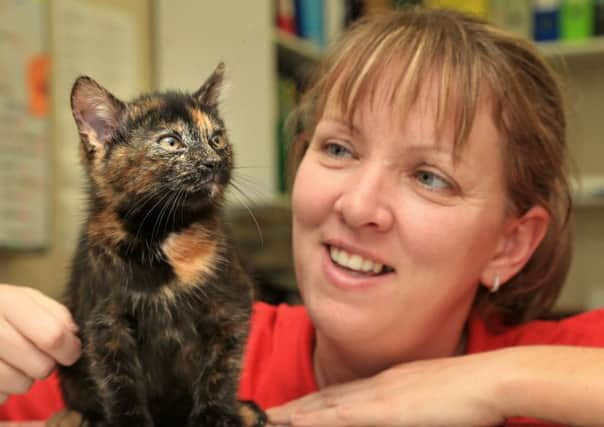One of world’s rarest cats given to rescue centre


Little Harry has raised eyebrows among experts at an animal welfare charity – by being one of the few male tortoiseshells in the world.
The unwanted 12-week-old kitten was handed into Lothian Cat Rescue in Bonnyrigg on Friday after his owners discovered they were allergic to his fur.
EDINBURGH EVENING NEWS E-EDITION
Advertisement
Hide AdAdvertisement
Hide AdHis rarity has sent the home into a tailspin.
Nicola Zelent, who has been a warden at Lothian Cat Rescue for 19 years, never imagined she would see a male tortoiseshell.
She said: “It’s very rare to get a male.
“If it is male, they’re normally a hermaphrodite.
“Harry shouldn’t be fertile, but there’s no way to know for another 12 weeks.
“There has never, ever been a male that has been fertile – and if he was, Harry would be worth a lot of money.”
Around 99.96 per cent of tortoiseshell cats are born female due to the way genes dictating coat colour are passed down.
The vet who identified Harry’s gender said it was the first time a career of more than 30 years that she had come across a male tortoiseshell. Margaret Riddell, of ICR vets in Gorebridge, said she had a “surprising” first encounter with the unusual cat.
“When I heard the cat was called Harry, I said to the owners, ‘I think that might have to be a Harriet’.
“I had to change my words when I discovered it was male. I’ve never seen one before and I’ve been a vet for more than 30 years.”
Advertisement
Hide AdAdvertisement
Hide AdIt’s believed he was purchased from private sellers who had no idea of how rare little Harry was.
Cat coat colour is passed down through the X chromosome, meaning it should be impossible for male moggies to inherit the mix of colours necessary to be born a tortoiseshell.
Of the eight million cats in Britain, only a couple a year are born male tortoiseshells.
But even if he is capable of mating, Harry will eventually be neutered and rehomed when he is old enough.
ODDS AGAINST CAT’s COAT ASTRONOMICAL
The odds against Harry the cat being born male were astronomical – and it’s all because of the genetics of cat coat colouring.
Male cats, like male humans, have only one X chromosome in their DNA, as opposed to females who have two. A cat’s colouring is inherited through the X chromosome, so it should be technically impossible for male cats to inherit the mix of hues necessary to produce a tortoiseshell coat.
But male tortoiseshells can be born through a genetic mutation that causes the cat to be born with two X chromosomes and one Y chromosome (XXY).
Such cats may be more feminine than typical males – and will always be sterile due to the imbalance of chromosomes.